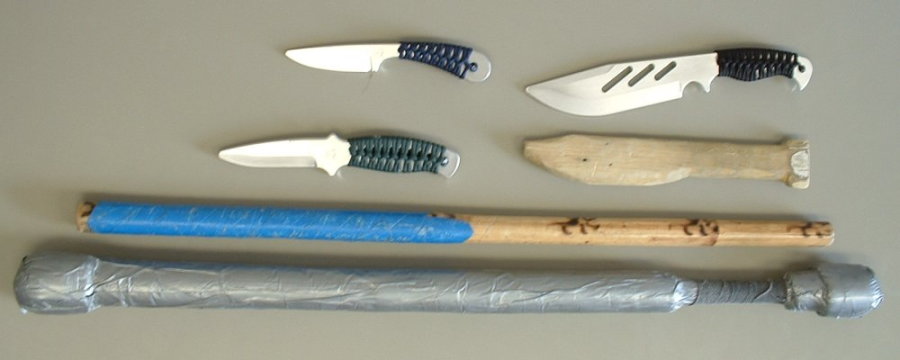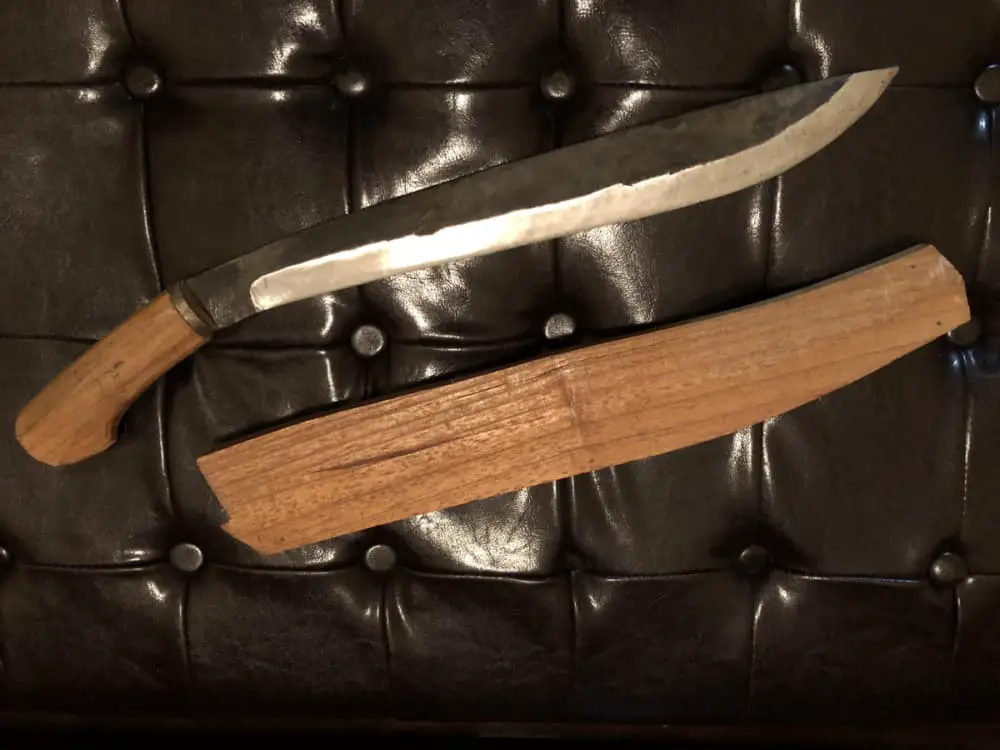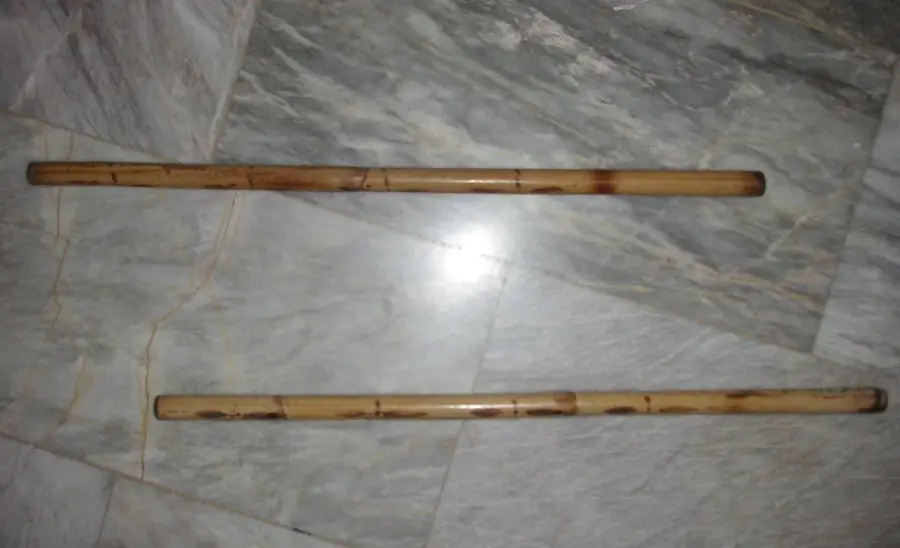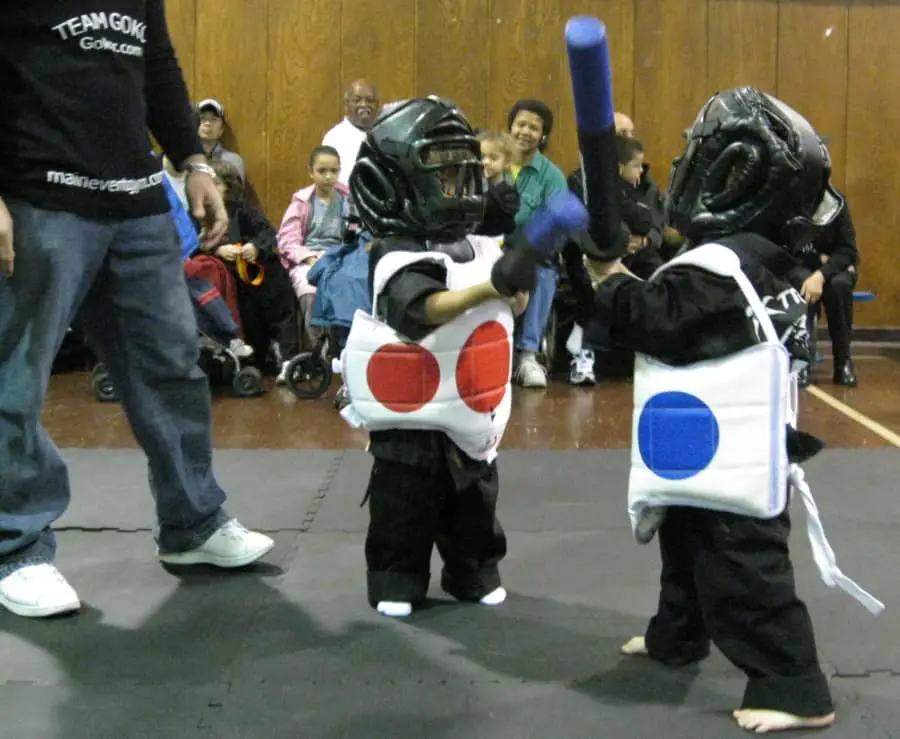
Not everyone is familiar with the leading bladed and impact weapons system in the world. That seems odd to say in the same sentence, but it is true. Many don’t immediately think of weapons when they think of the martial arts. Yet militaries around the world have adopted this system for impact and bladed weapons training.
What is Kali Martial Arts exactly? It is a weapons based Filipino martial art (FMA) that utilizes three main categories of weapons: bladed, impact, and improvised. This is then blended with empty handed grappling and striking techniques to form one of the world’s most complete systems.
How is it that more people haven’t heard of this system of weapons training? It’s pretty simple really. Many people see self defense much different in various parts of the world.
We can explore this and other questions about Kali martial arts and help parents as well as adult students get to know this highly effective system of self defense. This will be a comprehensive resource for both parents and prospective adult students.
Contents
- Where Did The Martial Art of Kali Get It’s Start?
- What Do Kali Practitioners Do And How Do They Train?
- Can Kids Learn Kali or Other Filipino Martial Arts?
- The Filipino Kali Martial Arts Takeaway…
Where Did The Martial Art of Kali Get It’s Start?
According to the National Mapping and Resource Information Authority (NAMRIA), the Department of Environmental and Natural Resources for the Republic of the Philippines, their country covers a vast distance and is comprised of 7641 islands.

These islands were not always a homologous group and throughout history have been at a near constant state of war between themselves and against outside invaders. A thousand years ago, the warring tribes developed martial techniques using the instruments that they had at hand. The bladed tools they had were knives and machetes of differing lengths.
As time went on, alliances between the tribes brought more unity, but peace never seemed to be in the Filipino story. Invasions from other nations though devastating, brought the peoples of the islands even more together. They defended their homes against the Chinese and later in the mid 16th century the Spanish Conquistadors arrived.
Through these battles the techniques of the blades, sticks, staves, and spears that we see today in Kali were developed and streamlined. The Spanish eventually conquered the islands and occupied the lands until 1898. Their influence on the martial arts, religion, and culture remain still to this day.
The Spanish Conquistadors And Their Influences On Filipino Martial Arts
The influence of the Spanish on the martial arts during their occupation came in the form of sword play and language, which was eventually integrated into the system. Through time these techniques and terms took on a distinct Filipino flavor, but their roots can still be seen even today.
The name Kali is traceable, at least with some degree of certainty to the root languages of the ancient tribes of the Philippines. There are many theories to what the word means and represents. Many believe that it stems from an ancient word meaning blade or to wield a blade. Some say it refers to cutting or scraping. Yet, scholars cannot be certain in a culture that has little written records.
Today, that is not the only name by which it is known. Many people know it by other names. Though the techniques and lineage of Guros that teach them are many times the same, other names like Escrima and Arnis are used. These are Spanish words that have their beginnings in the Spanish occupation of the islands 500 years ago.
Arnis comes from an older Spanish term (arnés) meaning armor. This holds true in the style and practice of those that claim this for their styles name. It tends to emphasis the more defensive aspects of Kali. These practitioners focus on disarming opponents rather than initially inflicting greater damage utilizing their weapons.
Kali Guro’s Note: In an effort to be honest and forthright, I would like to comment here that in all of my time in no-rules, real contact weapons bouts, disarming an opponent was rarely successful.
I am not saying that it is impossible. I have done it and seen it done. It just is so squarely on the unlikely side that it is a mistake to focus heavily on it. The much more high percentage solution is to cause damage to the arm holding the weapon, causing the attacker to be unable to wield it.
Escrima is also a term coming from the Spanish which was derived from the word esgrima (to fence). This is appropriate when one understands that the original intent of the word does not have the sport connotation that it does today. It was meant to signify bladed art proficiency in deadly combat.

Again, as in my other articles, I am in no way downplaying the role of sport training in the martial arts. I am simply decrying its takeover of many styles leading students to believe that the entirety of the system is contained in said sport manifestations. Fencing is not only a very effective training in a particular style of sword play, but it is rather beautiful in its application.
Many of the terms that students will use in a class teaching Kali today will also be Spanish. Here are a few…
- Abanico – Spanish term for hand fan. This refers to a movement in Kali where the weapon is flipped using the wrist like opening a asian style hand fan.
- Baston – A Spanish word for stick used in Kali training as an impact weapon or a training replacement for an edged weapon (knife or machete). These are normally made of rattan wood, treated with oils, and burned on the edges stop fraying of the fibers. For kids and beginner adult practice, padded variations are used.
- Corto – Spanish term meaning short. It refers in some variations of Kali to a close distance between you and your opponent.
- Espada y daga – This Spanish term is translated Sword and Dagger. It is direct evidence of the Spanish influence on the Filipino martial arts and culture. It refers to the use of a longer blade in conjunction with a shorter in a complex system of offensive and defensive strikes in lieu of using a sword and buckler or shield.
- Redondo – A Spanish word meaning round, round-trip, or return that is used to designate a weapon strike that makes a full circle return to the original position. This is usually done to gain momentum and thus power.
Later Developments To Kali And How Filipino Martial Arts Have Evolved
Though it began its existence as a military fighting system, over time it was disseminated into the cultures of the islands and used for self defense by individuals in a less than peaceful environment. It became common practice for many Filipino citizens to carry edges weapons and batons in their day to day lives to protect against the dangers of a moderately lawless society.
There are sadly hundreds and even some reports of thousands of duels using sticks and sometimes bladed weapons that occurred during the time of the past couple of centuries. This has only been outlawed with regulations that were expressly enforced in the 20th century.
To be clear, not all of these reports can be validated and many didn’t actually end with a winner.
This developed a system of bladed and impact weapon technique and skill that is unparalleled in other systems. Though this was a hard lifestyle led by the people on these islands in the South China Sea, the martial art that came from it is unprecedented.
Today, these systems have been codified and systematized making them easier and more accessible to learn for the average student. There are many levels of training that students go through in order to accurately learn to use these weapons systems for self defense.
Not all schools or Guros are the most effective at teaching students to make the leap from theory to practice. It takes a well designed delivery system and a skilled instructor to help students learn the practical applications of these weapons, but keep the safety and enjoyment factors high. There are many elements that must be present in training that I will go over next.
There is an important to note to be made here. The many centuries of extreme circumstances that began Kali should stand as a reminder to students today that seeking a character filled life is of utmost importance. The techniques they are learning can become destructive and detrimental to an entire society if they forsake the path of bettering themselves as humans and not just martial arts practitioners.
Many need to keep this in mind with the current gladiatorial sport trends with no regulation or mandate for good character. Instructors that accept any behavior or level of moral fiber in their students will contribute to this. It is all the more important when teaching the devastatingly effective techniques of martial arts styles like Kali.
What Do Kali Practitioners Do And How Do They Train?
One of the big aspects of Kali is its unique footwork. It is mainly based on the triangle and combinations of 45 degree angles building into larger triangles. Much of what a beginning student learns when starting a full kali program will be how to move using these matrix.
Because of the weapons used in this self defense system, it affords additional options for movement. ‘Trading’ blows that happens in many other martial arts systems is highly advised against in Kali. The damage these weapons can do is substantial and thus the movements reflect this. Distance control and movement are precisely based on footwork while striking, parrying, and blocking.
What Is Training Like In Kali?
A typical class in many Kali programs consists of all or portions of the following:
- Warm-up drills loosening wrists arms and legs with stick, knife, and empty hand motions combined with stretching.
- Footwork patterns are drilled to continue the warm-up and solidify proper movement for later practice.
- Double stick patterns (Sinawalli) are practiced for hand-eye coordination, reaction time, and distance control.
- Single stick and knife techniques for self defense are drilled.
- Empty hand transitions are practiced with pads, targets, partners, or heavy bags.
- Grappling with weapons in some forms of Kali are integrated with the techniques from the rest of the class.
- Padded weapons and empty-handed free practice is done with partners (sparring).
I am telling you the truth. I have sparred for thousands upon thousands of hours in nearly every single way that a martial artist can train. With the proper protective precautions (and without for those of us that are crazy) this is by far the most fun sparring in all of martial arts. Weapons based, or more specific, padded weapons based sparring is a blast.
You will get a cardio workout, learn a little about your self and abilities each time, and get to swing a weapon that boosts the respect someone has to give your attempts ten fold. A weapon is the great equalizer. The amount of damage one can do with a real weapon can’t be honestly disregarded.
There are many ways around the weapon for advanced Filipino martial artists, there is no doubt. Yet, even beginners wielding weapons have to be given consideration and can’t simply be dismissed.
Besides, sometimes getting geared up and feeling like a modern day warrior is half the fun. And on top of it all, the weapon makes what you are doing extremely effective in a real life self defense situation, as long as there is full speed, safe contact.
Kali Is A Weapons Based Filipino Martial Art
There are three main categories of weapons training in the Filipino martial arts.
- Bladed Weapons
- Impact Weapons
- Improvised Weapons

Though projectile weapons have been added in recent decades, those are primarily trained in by military or police forces. These are the three categories most Kali students will encounter in their classes or training groups.
Bladed Weapons in Kali Martial Arts
The reality is, bad guys don’t care about you, your family, or your safety. There is a saying that even many honest police officers will repeat to you.
When seconds matter, the police are only minutes away.
Bladed weapons if used correctly can save you and your family in a serious self defense situation. This doesn’t mean you are preparing to take someone’s life. This training should be undertaken with the intent to get the assailant to stop and leave.
There are many bladed weapon variations with only slight changes in blade length, balancing, or shape. They all had specific uses that today may not be readily apparent. One of the most common shapes is the one found in the bolo or cutting knife. It is a versatile utilitarian blade used much like many would recognize as a machete. It is very tip waited for maximum swing velocity and impact.

As you can imagine, this can not be used in practice. It is a rule of any good Kali Guro that no live blades (sharp) are allowed in a training area. What is usually used in its place are aluminum trainers for non to light contact practice, rattan sticks for light to medium contact, or padded weapons for real or full contact.
There are also shorter daggers or knives used in training the Filipino martial arts. The defensive applications of this are innumerable. There are very few empty handed techniques that can overcome a fully trained Kali knife wielding defender. Armed with these techniques and a secure grip on a knife, a much smaller person can hold off multiple larger assailants.
Impact Weapons of the Filipino Martial Arts
Utilizing many of the same movements with slight modifications, students in FMA will use sticks of different sizes as impact weapons and substitutions for sharp ones. The stick has become the symbol of Kali, Escrima, and Arnis around the world.

Some even mistakenly call the FMA ‘stick arts’. This mistake is usually corrected on the first class when the student sees the wide range of concepts, but it is understandable since the stick is often a training tool of choice in Kali.
These training tools are usually made of solid rattan, treated with oils, and burnt on the ends to stop fraying fibers. There are sometimes patterns burned along the length as well, but normally this is covered by tape to make the stick last longer and cut down on fraying.
One of the more popular training methods for beginning to intermediate students is called Siniwali. According to the Manila Times newspaper, this means pattern or weaving in Tagalog, the unified language of the Republic Of The Philippines. They are predetermined patterns that two partners both execute together.
The fun really stars when adults and even kids get to where they can fly with these patterns. These are great for demonstrations, tournament competitions, and amazing training for hand eye coordination. There is a great sense of accomplishment when you can do a string of 10 different patterns in a row at full speed.
There is also the extremely fun aspect of padded weapons and their use against an actively resisting partner. Like I said earlier, this is one of the more enjoyable aspects of martial arts training. The padded gear comes in many different forms. Here are some of the ones I like the most…
The weapons padded headgear I would use every time can be found here on Amazon at this link. Check it out. It is good protection and looks less dorky than many of the other headgear on the market.
Here you can find the best padded sticks (some call them swords) on the market. We used a specifically harder version for training even for international level fights.
You will also need some gloves. That should be your main target until they start dropping their hands. Since that it the case, you will want to have a good pair of kali gloves like these found on Amazon.
Improvised Weapons Of Kali Martial Arts
There should be no time that anyone, and I mean any adult should be unprotected by some sort of weapon that they have at least moderately trained in. There are numerous variations of deterrent style weapons for even the most passive of individuals.
If you are leaving your own self defense to chance, that means you are leaving your responsibility to others. This on top of the fact that they may not even be there when needed.
There are simple weapons that will make most attackers move on to seek other more unprepared targets. Some of them are even in the form of everyday items. For one of many, I carry a tactical flashlight at all times. This is not only for utilitarian purposes, but for self defense reasons as well.
The one I carry has a 4.5 million volt taser, flashlight, and beveled edge for striking. It looks like a small simple flashlight. If you are interested, click on the banner below and you can get the one I carry for a very good price.

This is not the only meaning of improvised weapons. There is also the use of objects that are in close proximity, utilizing the angles of attack practiced with the normal weapons of the system. For instance, many of these objects can be used to stave off violent attackers:
- Pencils
- Pens
- Books
- Rulers
- Canes
- Umbrellas
- Rolling Pins
- Back Scratchers
- Lamps
- Statues
- Tables
- Chairs
Of course, much more training is needed to use weapons that weren’t specifically designed for the purpose of being used in that way. The concepts of handling and using weapons that are taught in Kali are directly applicable to most any weapon you can pick up, whether impact, bladed, or improvised.
The Empty Handed Training Of Filipino Martial Arts
As with other martial arts styles, Kali has two main categories when it comes to empty handed techniques. There are are striking techniques and concepts and there is grappling or wrestling.
There is not only the unique systems of striking that Kali utilizes from the influence of weapons training, but there is also many forms of the art that have borrowed many things from other styles of self defense and sport fighting.
Empty Handed Martial Arts Striking In Kali
The techniques used in Kali that are not using a weapon’s force multiplication advantage attempt to use the same angles of attack. This is done in an effort to simplify the movements practitioners have to master and make them more useful in the adrenal state.
If you have ever had an adrenaline dump due to a scare or highly anxious situation, you know that many of your thoughts as well as small motor functions become delayed and muddled. This is why keeping the same movement with or without a weapon can be such an effective concept.
Kali Guru’s Note: Here I want to be as honest and transparent as I can. These empty hand techniques by in large (I know there are always exceptions) are not going to be on par with the power and speed of say a trained Muay Thai fighter. Though this is not their intent, in fairness to these empty handed focused systems, this is the case.
That being said, the purpose of these techniques could not be more different than those of sport striking stylists. For a sport combat striking competitor, gaining points or a knockout is the primary reason for throwing strikes. The goal of empty hand striking in Kali, Escrima, or Arnis is twofold…
- They are used as auxiliary techniques and distractions while still retaining and utilizing a weapon.
- They are used as a means to get the Kali practitioner or Escrimador to their weapon, another weapon, or an improvised one.
Though some may develop these techniques to a high level, they aren’t going to be able to surpass what they were designed for. They were not designed to deliver large knockout power over several rounds of fighting. If within one to two minutes, the person has not reached some usable weapon, the focus of the empty hand techniques has been missed.
Grappling Techniques In Filipino Martial Arts
One of the terms or names given to the specific style of grappling native to FMA is Dumog. This is a style that developed over centuries coming from wrestling and take-downs to its more hybridized submission grappling style today.
One of the very noticeable things about the non-sport side of Dumog is its emphasis on grappling with bladed and impact weapons. This is unlike any other grappling system in the world. Because of this, it has kept more of its throwing and position based roots, since control of the weapon is of primary importance and takes priority over committing entirely to finding away to apply a breaking or choking hold on an opponent.
This style of grappling is incorporated in many of the systems of Escrima or Kali a student is likely to come across. Some many prefer the standing techniques while others may emphasize the ground grappling side.
Then there is the influence of styles such as Judo, Brazilian Jiu Jitsu, and Submission Grappling. Their worldwide reach has also colored some of what you will see in this Filipino art that may not have been there a hundred years earlier.
Can Kids Learn Kali or Other Filipino Martial Arts?
For the short answer to this question, absolutely! As I have and probably will state again in these articles, any instructor that has seen what I have seen in terms of kids responding to Kali would be on the phone tomorrow with the nearest Kali instructor to train in FMA.
There is no doubt that kids enjoy any art that has sticks and swords. And even better, in Kali they get to smack them together in patterns and put on gear while wielding padded versions. There is few better motivators for a shy child or better control incentives for a rambunctious one than the possibility of swinging padded weapons at one another’s weapon helmets.
You throw a couple of padded swords in the middle of a group of boys and see what happens. Immediate Light Sabre battles will ensue.
How Does Weapons Training Work With Kids?
The first thing to note about training kids, is that they should never be taught to use the weapons as bladed. They should always be taught with the impact or improvised versions in mind. Teaching kids to fight with knives is simply unethical.
Sure, they are going to pretend that the padded weapons are swords, but they really don’t know what a sword is or can do. Most adults don’t really understand it to be honest. Bladed weapons can devastate the human body.
Kids should be using rattan sticks for air or patterned practice. All other times should be done with soft, padded versions. Children get bored easily and have poor impulse control. All of a sudden the thought may pop into Oliver’s head to see if he can make Joey’s hair move by smacking his stick into it.

Whenever kids are using padded weapons, there should also be at a minimum, headgear with face-masks. The eyes and soft tissue areas of the face should be completely protected even though the padded weapon shouldn’t cause much damage. It doesn’t matter how padded the weapon is, a hit to the eye will hurt.
Gloves, chest protection, and shin and instep protection is also needed if empty handed strikes are going to be allowed to be used as well. One plus to this is that the kids get to pad up like RoboCop™ or a Samurai. For those of you with kids that are particular about what they wear, just emphasize that this is a warriors costume and it should get the ball rolling.
What Does Training Look Like For Kids In Kali Martial Arts?
There are many, many forms of drills that are great for kids to learn and practice. There is also the cultural aspects that children should be exposed to when learning a language or martial art from that nation.
In the Filipino culture, they have a traditional dance that is excellent for training foot speed, balance, and coordination to children studying Kali. It is called Tinikling. The movements are set to music and two long bamboo poles are used. The poles are hit together and the dancers move in and out of them avoiding getting pinched by as the two come together.
This is a great addition to any children’s kali class with or without music. There is also sinawali or the patterned practice of hitting sticks together with a partner to develop hand-eye coordination, speed, and distance control. These patterns also will give a great sense of accomplishment once mastered. They can be fairly impressive if performed in front of crowds at high enough speeds.
Then there is padded weapons sparring and practice, empty hand striking as in most Karate dojos, and grappling practice like any Judo training club. Tailoring Kali for kids is an easy proposition seeing as it has so many avenues from which to pull techniques and drills.
The Filipino Kali Martial Arts Takeaway…
The Filipino culture is old and complex with many twists and turns in its history. Along the arduous journey that it took, its people developed an amazingly effective martial arts system that militaries and individuals alike can take advantage of to protect ourselves, our families and our homes.
It is a weapons based system that has all the elements of a complete martial arts style with empty hand grappling and striking. The weapons are not only ancient and steeped in history, but usable by the average person in today’s societies. The improvised weapons that we have all around us every day can also be fit directly into the techniques.
Kids and adults alike can benefit from its practice and can have a lifelong tool to use in case of dangerous situations. With the right virtue based instruction from instructors who monitor the character of their students, this type of martial art could positively affect even the communities around the students by their examples and actions.
Meekness is defined as strength under control. That is an apt name for the potential of Kali in the hands of virtuous students. It can help them walk proudly and stand up for the good effectively. There is no substitute for good character, but to protect the safety of those who wish to practice it, sometimes we must follow the words of a former U.S. president.
Speak softly and carry a big stick
Theodore Roosevelt
In terms of Filipino Kali Martial Arts, that sentiment could not be more apropos. The power of the world’s most formidable marital arts must be controlled by people of virtue. Children must be taught with this in mind. If we are to make the world better, we must start by enabling our children with the ability to protect good from evil and the right character that will enable them to tell the difference.
